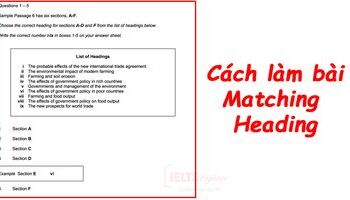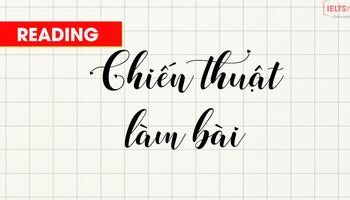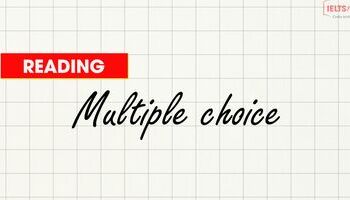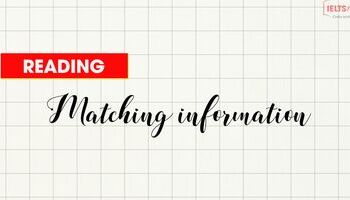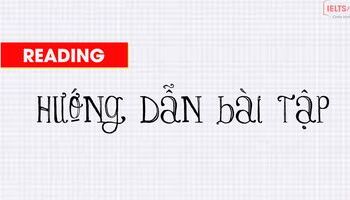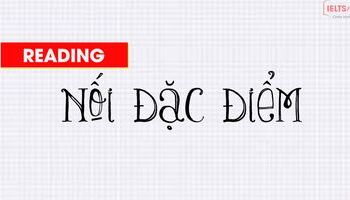Đến với bài học hôm nay, chúng ta cùng tìm hiểu dạng bài Matching Heading trong IELTS Reading nhé. Đây là dạng bài khá khó nhưng nắm vững kiến thức thì dễ dàng chinh phục được điểm cao nha.
Matching Heading Questions là gì?
Matching Heading luôn là dạng bài tập 'khó xơi' do số câu hỏi nhiều, tốn thời gian làm bài và đòi hỏi bạn phải hiểu nội dung bài đọc thì mới chọn đúng đáp án. Tuy nhiên, nếu bạn biết bí quyết thì Matching Heading sẽ không còn là trở ngại. Nhiệm vụ của thí sinh là nối 5-7 tiêu đề cho các đoạn văn trong bài văn.
Hai phần nối này không giống nhau về số lượng, sẽ có nhiều tiêu đề hơn đoạn văn và thí sinh sẽ phải lựa chọn để nối với đúng nội dung của đoạn văn trong bài thi.
- LƯU Ý:Đối với dạng bài này, sẽ luôn có nhiều tiêu đề hơn số đoạn văn trong bài.
Đây là format bài thi Matching Heading

Chiến thuật làm bài
Bước 1 Đọc các tiêu đề (headings) và xác định từ khóa
Bước 2 Tìm câu chủ đề (topic sentences) hoặc đọc lướt các đoạn để nắm được nội dung chính.
Bước 3 Xác định từ đồng nghĩa/ trái nghĩa hoặc cách diễn đạt tương đương ( paraphrasing) giữa các tiêu đề và câu chủ đề ở các đoạn
Bước 4 Chọn câu trả lời.
Chúng ta cùng phân tích các bước theo bài dưới đây.
Read the passage and do the task below
A. Aromatherapy is the most widely used complementary therapy in the National Health Service, and doctors use it most often for treating dementia. For elderly patients who have difficulty interacting verbally, and to whom conventional medicine has little to offer, aromatherapy can bring benefits in terms of better sleep, improved motivation, and less disturbed behaviour. So the thinking goes. But last year, a systematic review of health care databases found almost no evidence that aromatherapy is effective in the treatment of dementia. Other findings suggest that aromatherapy works only if you believe it will. In fact, the only research that has unequivocally shown it to have an effect has been carried out on animals.
Choose the correct heading for paragraph A, C—E and G from the list of headings below.
Write the correct number i—ix in boxes 1-5 on your answer sheet.
1. Paragraph A
List of Headings
i Remembering the past more clearly
ii Bringing back painful memories
iii Originally an alarm signal
iv The physical effects of scent versus image
v Checking unreliable evidence
vi Reinforcing one sense with another
vii Protection against reliving the past
viii The overriding power of sight and sound
ix Conflicting views
Bước 1. Đọc các tiêu đề (headings)
và xác định từ khóa
- Các tiêu đề thường bắt đầu bằng cụm danh từ, theo sau bởi một cụm giới từ hoặc mệnh đề quan hệ.
Ví dụ:
- Remembering the past more clearly
Cụm danh động từ/ tính từ
- Bringing backpainful memories
Cụm danh động từ/ cụm danh từ
- Từ khóa trong các tiêu đề là những từ nắm nội dung chính của tiêu đề, thường là danh từ, động từ, tính từ,…
Xác định và gạch chân các từ khóa
iii Originally an alarm signal
iv The physical effects of scent versus image
v Checking unreliable evidence
vi Reinforcing one sense with another
vii Protection against reliving the past
viii The overriding power of sight and sound
ix Conflicting views
Bước 2. Tìm câu chủ đề (topic sentences)
hoặc đọc lướt các đoạn để nắm được nội dung chính.
Một vài cách để tìm topic sentence: dựa vào vị trí hoặc từ chuyển tiếp
Dựa vào vị trí: Câu chủ đề thường nằm ở những vị trí sau theo thứ tự phổ biến:
- Câu mở đầu đoạn.
- Câu kết thúc đoạn
- Câu thứ hai của đoạn văn (điều này thường được áp dụng khi câu đầu tiên của đoạn văn là câu hỏi, hoặc từ bắt đầu câu thứ hai là But, However, Yet, …).
Trong trường hợp đọc cả 3 câu trên vẫn chưa tìm được câu chủ đề, sẽ có 2 trường hợp xảy ra:
- câu chủ đề nằm ở giữa đoạn
- Đoạn văn không có câu chủ đề Khi đó cách duy nhất là đọc cả đoạn để tìm xem ý chung nhất của đoạn ấy là gì.
Dựa vào transitional word (từ chuyển đoạn hoặc liên từ)
- Câu chủ đề thường bắt đầu bằng các từ But, Yet, The point is, The truth is, Above all, Obviously, Overall, In reality, In general, The main point is, …,
- Câu bổ sung ý/ luận cứ (supporting sentence) thì thường có các từ như: For example, Notably, First, second, last, For instance, Take … as an example, Particularly, to illustrate….
Một vài cách khác để tìm topic sentence
- Chú ý bỏ qua các câu hỏi, câu hỏi không phải là câu chủ đề.
- Các câu có chủ ngữ pronoun (they, it, he, she…) thường không phải là topic sentence, do pronoun được dùng để thay thế cho một danh từ đã được nhắc đến ở câu trước cho nên các câu có pronoun thường chỉ là để đưa thêm các “detail” cho các câu trước đó.
Ví dụ: Xác định câu chủ đề của đoạn A
Aromatherapy is the most widely used complementary therapy in the National Health Service, and doctors use it most often for treating dementia. For elderly patients who have difficulty interacting verbally, and to whom conventional medicine has little to offer, aromatherapy can bring benefits in terms of better sleep, improved motivation, and less disturbed behaviour. So the thinking goes. But last year, a systematic review of health care databases found almost no evidence that aromatherapy is effective in the treatment of dementia. Other findings suggest that aromatherapy works only if you believe it will. In fact, the only research that has unequivocally shown it to have an effect has been carried out on animals.
Câu chủ đề nằm ở câu “But last year, a systematic review of health care databases found almost no evidence that aromatherapy is effective in the treatment of dementia”.
Bước 3. Xác định từ đồng nghĩa/ trái nghĩa
hoặc cách diễn đạt tương đương giữa các tiêu đề và câu chủ đề ở các đoạn
→ Câu chủ đề bày tỏ quan điểm đối lập với ý của các câu trên vì có từ “ But,….. no evidence that aromatherapy is effective in the treatment of dementia…”
Point 1, but point 2= conflicting view
Bước 4. Xác định tiêu đề phù hợp
Đối chiếu với các tiêu đề (Headings), chỉ có Heading “ix Conflicting views- những quan điểm đối lập” là hợp lý nhất.
Check- up - Luyện tập
Read the rest of the passage and answer the question 2-5
B. Behavioural studies have consistently shown that odours elicit emotional memories far more readily than other sensory cues. And earlier this year, Rachel Herz, of Brown University in Providence, Rhode Island, and colleagues peered into people's heads using functional Magnetic Resonance Imaging (fMRI) to corroborate that. They scanned the brains of five women while they either looked at a photo of a bottle of perfume that evoked a pleasant memory for them, or smelled that perfume. One woman, for instance, remembered how as a child living in Paris—she would watch with excitement as her mother dressed to go out and sprayed herself with that perfume. The women themselves described the perfume as far more evocative than the photo, and Herz and co-workers found that the scent did indeed activate the amygdala and other brain regions associated with emotion processing far more strongly than the photograph. But the interesting thing was that the memory itself was no better recalled by the odour than by the picture. "People don't remember any more detail or with any more clarity when the memory is recalled with an odour," she says. "However, with the odour, you have this intense emotional feeling that's really visceral."
C. That's hardly surprising, Herz thinks, given how the brain has evolved. "The way I like to think about it is that emotion and olfaction are essentially the same thing," she says. "The part of the brain that controls emotion literally grew out of the part of the brain that controls smell." That, she says, probably explains why memories for odours that are associated with intense emotions are so strongly entrenched in us, because smell was initially a survival skill: a signal to approach or to avoid.
D. Eric Vermetten, a psychiatrist at the University of Utrecht in the Netherlands, says that doctors have long known about the potential of smells to act as traumatic reminders, but the evidence has been largely anecdotal. Last year, he and others set out to document it by describing three cases of post-traumatic stress disorder (PTSD) in which patients reported either that a certain smell triggered their flashbacks, or that a smell was a feature of the flashback itself. The researchers concluded that odours could be made use of in exposure therapy, or for reconditioning patients' fear responses.
E. After Vermetten presented his findings at a conference, doctors in the audience told him how they had turned this association around and put it to good use. PTSD patients often undergo group therapy, but the therapy itself can expose them to traumatic reminders. "Some clinicians put a strip of vanilla or a strong, pleasant, everyday odorant such as coffee under their patients' noses, so that they have this continuous olfactory stimulation." says Vermetten. So armed, the patients seem to be better protected against flashbacks. It's purely anecdotal, and nobody knows what's happening in the brain, says Vermetten, but it's possible that the neural pathways by which the odour elicits the pleasant, everyday memory override the fear-conditioned neural pathways that respond to verbal cues.
F. According to Herz, the therapeutic potential of odours could lie in their very unreliability. She has shown with her perfume-bottle experiment that they don't guarantee any better recall, even if the memories they elicit feel more real. And there's plenty of research to show that our noses can be tricked, because being predominantly visual and verbal creatures, we put more faith in those other modalities. In 2001, for instance, Gil Morrot, of the National Institute for Agronomic Research in Montpellier, tricked 54 oenology students by secretly colouring a white wine with an odourless red dye just before they were asked to describe the odours of a range of red and white wines. The students described the coloured wine using terms typically reserved for red wines. What's more, just like experts, they used terms alluding to the wine's redness and darkness—visual rather than olfactory qualities. Smell, the researchers concluded, cannot be separated from the other senses.
G. Last July, Jay Gottfried and Ray Dolan of the Wellcome Department of Imaging Neuroscience in London took that research a step further when they tested people's response times in naming an odour, either when presented with an image that was associated with the odour or one that was not. So, they asked them to sniff vanilla and simultaneously showed them either a picture of ice cream or of cheese, while scanning their brains in a fMRI machine. People named the smells faster when the picture showed something semantically related to them, and when that happened, a structure called the hippocampus was strongly activated. The researchers' interpretation was that the hippocampus plays a role in integrating information from the senses— information that the brain then uses to decide what it is perceiving.
Choose the correct heading for paragraph A, C—E and G from the list of headings below.
Write the correct number i—ix in boxes 1-5 on your answer sheet.
1. Paragraph A- ix
2. Paragraph C
3. Paragraph D
4. Paragraph E
5. Paragraph G
Example Answer
Paragraph B iv
Paragraph F V
List of Headings
i Remembering the past more clearly
ii Bringing back painful memories
iii Originally an alarm signal
iv The physical effects of scent versus image
v Checking unreliable evidence
vi Reinforcing one sense with another
vii Protection against reliving the past
viii The overriding power of sight and sound
ix Conflicting views
Mẹo làm bài IELTS Reading Matching Headings
Những vấn đề cần chú ý
Khi làm dạng bài này, thí sinh thường gặp những vấn đề sau đây mà cần chú ý khắc phục
- Thấy đoạn văn quá dài, nản. Điều này không hiếm bởi khi thấy bài quá dài, bạn cảm thấy không muốn đọc.
- Không đọc toàn bài mà lướt qua, đọc không chú trọng, muốn đọc nhanh.
- Nhầm lẫn giữa các Heading giống nhau
- Thói quen ghép từ và chỉ chú trọng vào một keysword mà không tìm từ đồng nghĩa
- Bạn cố gắng đọc quá nhanh, chỉ đọc những dòng đầu tiên. Điều này không tốt vì bạn không hiểu hết ý nghĩa của bài. Câu topic sentence thường nằm ở những dòng đầu tiên. Bạn tập trung đọc những dòng này. Tuy nhiên, thỉnh thoảng bản nên đọc cả những dòng cuối để chắc chắn đáp án của mình, vì câu cuối cùng thường tóm tắt lại ý chính của đoạn văn.
- Chỉ chú trọng vào từ vựng chung chung, có thể nối với nhiều đoạn
- Dành quá nhiều thời gian vào một đoạn văn: Khi gặp đoạn văn khó bạn thường mất nhiều thời gian để đọc.
Tips làm bài:
- Bài dài nhưng để nắm được ý chung thì bạn cần đọc toàn bài. Điều này là rất cần thiết nên nếu cảm thấy khó thì vẫn phải đọc.
- Hãy chú ý đến từ đồng nghĩa để tránh sập bẫy. Ví dụ bạn thấy trong heading, bạn có “environmental” nhưng ta không tìm chính xác từ này trong đoạn văn vì có sự thay thế từ ở đây. Bạn cần chọn đoạn chứa từ “green”. Bởi ở đây người ta có sử dụng cách paraphrasing.
- Đọc kỹ Heading và nối theo từng đoạn được cho để kiểm tra độ logic nếu bạn sẽ thấy Heading giống nhau, có ý nghĩa tương tự nhau. Có thể bạn thấy mất thời gian nhưng đừng bỏ qua để tránh lỗi không đáng có.
- Tránh việc chỉ chú trọng vào từ vựng chung chung, có thể nối với nhiều đoạn. Quan tâm đến những từ vựng đặc biệt chỉ dành riêng cho heading đó.
- Nếu gặp khó, hãy để đó và làm câu dễ trước. Vì thời gian bài thi sẽ giới hạn nên đừng cố quá ở câu khó. Bên cạnh đó, sau khi hoàn thành các câu trả lời khác thì bạn sẽ hiểu hơn về bài văn. Đừng cố phỏng đoán mà hãy làm bài dễ trước, sau đó quay lại lần nữa để trả lời.
- Câu đầu tiên/câu cuối cùng chưa chắc là câu topic sentence.
- Đọc headings trước, đọc đoạn văn sau. Cố gắng đọc headings 1 lần và ghi nhớ nghĩa của tất cả headings để khi vừa đọc đoạn văn, vừa suy nghĩ xem headings nào thích hợp, không bị mất thời gian lật qua lật lại đọc lại headings 1 lần nữa.
- Làm dạng Matching Headings sau cùng vì nó mang tính tổng quát. Khi làm tất cả các câu hỏi khác là bạn đã có cơ hội đọc lướt cả bài đọc, nắm được sơ sơ ý của bài.
Luyện tập
Passage 1
Choose the correct heading for paragraph A— G and from the list of headings below.
Write the correct number, i-x, in boxes 1-6 on your answer sheet.
List of Headings
i. The subconscious nature of gestures
ii. The example of regional differences
iii. The key factors of gestures
iv. Sending out important signals
v. How a well-known gesture loses its meaning
vi. Performance in a specific setting
vii. Recent research of Gesture Variant
viii. Comparison to an everyday-use object
ix. How will conflict be handled
x. Individual deviation of cultural norms
1. Paragraph A
2. Paragraph B
3. Paragraph C
Example Answer
Paragraph D - i
4. Paragraph E
5. Paragraph F
6. Paragraph G
Gesture
A. Gesture is any action that sends a visual signal to an onlooker. To become a gesture, an act has to be seen by someone else and has to communicate some pieces of information to them. It can do this either because the gesturer deliberately sets out to send a signal or it can do it only incidentally. The hand-wave is a Primary Gesture, because it has no other existence or function. Therefore, to make it a gesture, first, it should be clear and unambiguous. Others would be able to understand it instantly when it is shown to them. Nor may any component of a gesture, its force, its direction and amplitude of movement, be altered: otherwise, confusion or misunderstanding may occur.
B. Most people tend to limit their use of the term “gesture” to the primary form the hand-wave type—but this misses an important point. What matters with gesturing is not what signals we think we are sending out, but what signals are being received. The observers of our acts will make no distinction between our intentional primary gestures and our unintentional, incidental ones. This is why it is preferable to use the term “gesture” in its wider meaning as an "observed action". This can be compared to the ring of a telephone. The speed, tone and intensity of a telephone remain the same for any phone call. Even the length of time before being told that the number you are dialing is not answering, unless the caller hangs up, is the same.
C. Some gestures people use are universal. The shoulder shrug is a case in point. The shrug is done by bringing the shoulders up, drawing the head in, and turning the palms upwards so as to reveal that nothing is hidden. The shoulder shrug can also demonstrate submission or that what is being said isn’t understood. Another example is that an angry person usually expresses his rage by waving his clenched fist rapidly and forcefully. Surprisingly, you may find that people of different cultures will do the same when they are offended. That is to say, a commonly accepted gesture is shared by them. But if the way the hand is clenched changes, or the amplitude of force and the direction the fist is waved alters, the gesture no longer means the same.
D. So, is gesture born with us or is it developed as we grow up? Recent research found that gesture is more like a spontaneous reaction when we face certain situations. And we just do that automatically. When people talk, they almost always gesture with their hands. This expressive movement can be coaxed into a choreographic form if observed carefully. People can practice spontaneous gesture by forming pairs, then observing and questioning each other. They then show the group what they have collected from their partners. It is fun to surprise a group using this technique. Because spontaneous gestures are often unconscious, people will sometimes be surprised to have their gestures mirrored back to them, saying “Did I really do that?”
E. The attention of research was also drawn to cultural themes. Researchers discovered that if a person has a good set of teeth, he or she would be prone to have a bigger smile than he or she should when good things happen. And if a person possesses a bad set of teeth, he or she would tend to have his or her mouth shut when being teased. And people’s reaction to the same joke also varies: some laugh out loud while others titter. However, this does not cause confusion and it helps to develop our “behavioural”, which is an important aspect of our identity. It was referred to as a Gesture Variant, which indicates that individuals’ gesture production is a complex process, in which speakers’ internal and external factors and interactions could play a role in multi-modal communication.
F. During the research, an interesting phenomenon soon caught researchers’ attention. A hand purse gesture, which is formed by straightening the fingers and thumb of one hand and bringing them together so the tips touch, pointing upwards and shaping like a cone, carries different meanings in different countries. In Malta, it means heavy sarcasm: "you may seem good, but you are really bad.”; in Tunisia, it is against recklessness, saying "slow down”; in Italy, it means “What’s the matter?” or "What are you trying to say?”; in France, it means "I am afraid". However, this gesture has no clear meaning in American culture. And of course, the way the gesture is conducted is similar in different countries.
G. But what will happen if the gestures of different countries confront each other? The situation is further complicated by the fact that some gestures mean totally different things in different countries. To take one example, in Saudi Arabia, stupidity can be signalled by touching the lower eyelid with the tip of the forefinger. But this same gesture, in various other countries, can mean disbelief, approval, agreement, mistrust, scepticism, alertness, secrecy, craftiness, danger, or criminality. So people are faced with two basic problems where certain gestures are concerned: either one meaning may be signalled by different actions, or several meanings may be signalled by the same action, as we move from culture to culture. The only solution is to approach each culture with an open mind and learn their gestures as one would learn their vocabulary. These all require considerable skill and training and belong in a totally different world from the familiar gestures we employ in everyday life.
Luyện theo video trên nữa nhé.
Chúc các bạn học tốt.
